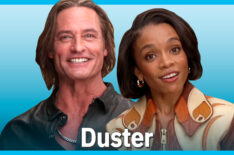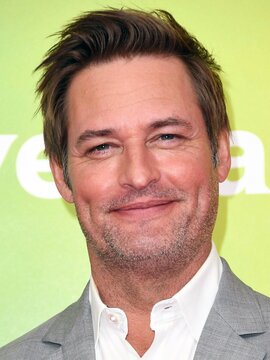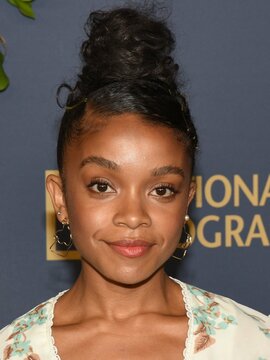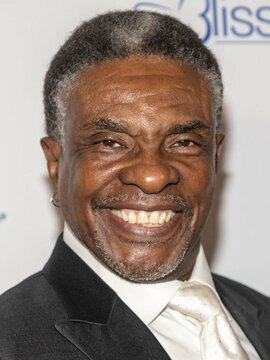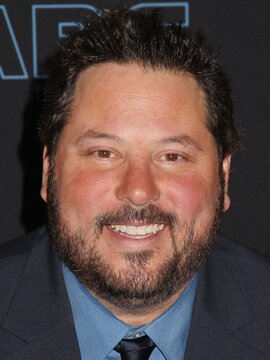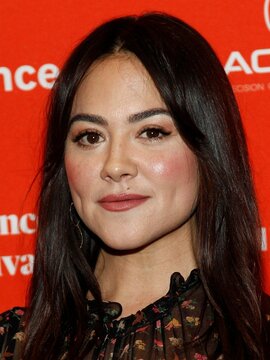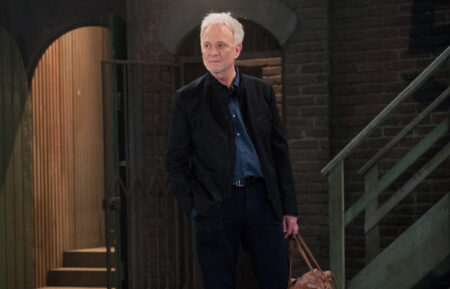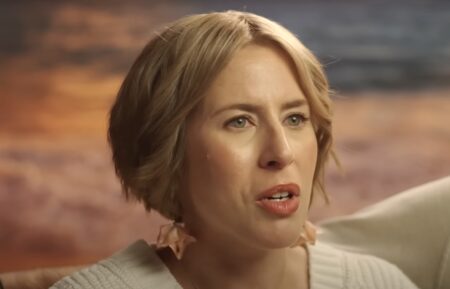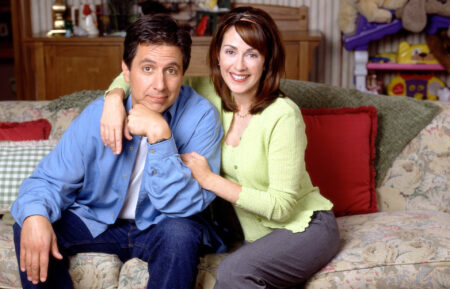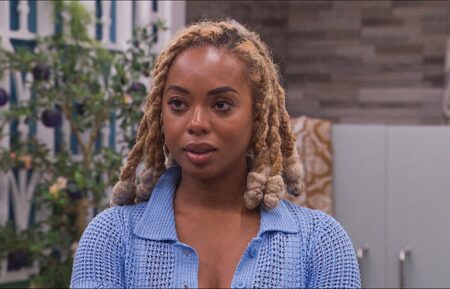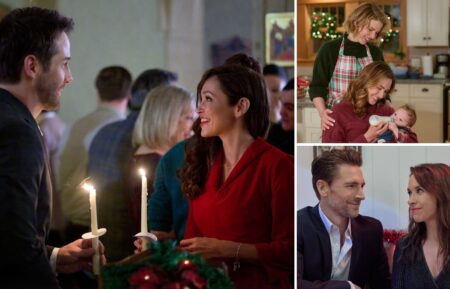‘Duster’ Director on That Gory Death, Jim & Nina’s True Connection & More Details
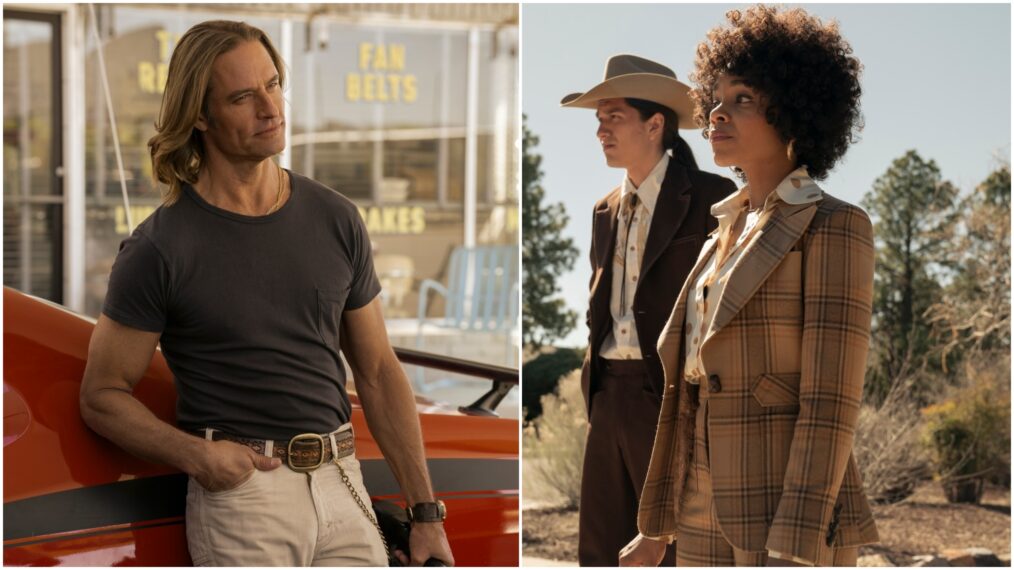
Spoiler Alert
[Warning: The following post contains MAJOR spoilers for Duster Episodes 1 and 2.]
The newest episode of Duster, like the series’ first, is stylish, surprising, and full of expectation subversions. Both segments were directed by Steph Green, who worked in close concert with Duster cocreators J.J. Abrams and LaToya Morgan to bring their groovy vision and characters to life. Each features slick action sequences and comedic beats to complement the ’70s-set crime drama at the center of the story.
Green, who’s also known for her work in The Americans, Billions, Scandal, and the Star Wars series The Book of Bobba Fett and Ahsoka, also directs two later episodes in the series (Episodes 5 and 6) and has some deep insight into the inner workings of the new Max original.
First, a recap of events in Thursday’s (May 21) newest installment: It begins with Jim Ellis (Josh Holloway) in the desert, scrambling to bury a body with a broken shovel when a mystery car drives up. We then flashback 15 hours to find out how the driver-for-hire got himself into this mess. Turns out, the man who watched him sign the confidential informant paperwork with Nina (Rachel Hilson) is Sergeant Groomes (Donal Logue), who’s now shaking Jim down for $10,000 in exchange for his silence, or he’ll rat Jim out to Ezra Saxton (Keith David). Instead of paying up, Jim has a different approach to being blackmailed.
Following a frustrating parking lot meeting with Nina — after which Nina reveals her method for keeping cool with a series of grunty pushups — Jim confers with Sunglasses (Patrick Warburton), a shades-wearing hired gun whom we meet at a retro bowling alley. He agrees to help get Groomes off Jim’s back by proving the man is a pedophile, but he wants $1,000 in return. Even after receiving an unexpected cash bonus from his boss for the organ retrieval operation that saved Saxton’s son’s life (and landed Jim in the FBI’s purview), Jim doesn’t have that kind of scratch on hand, so he offers to get him Elvis’ iconic blue suede shoes instead. This takes Jim to Palm Springs, where he runs into Saxton’s daughter Genesis (Sydney Elisabeth), who’s got some gripes about her father’s misogynistic worldview that he won’t let her take a position of importance within the company.
From there, things spiral completely out of control. When Sunglasses meets with Sergeant Groomes and reveals the films he found at his home, Groomes draws his gun. Although Sunglasses gets a shot on him, Groomes shoots back and gets Sunglasses’ sidekick in the head. Now Sunglasses wants the shoes and the sunglasses from Jim, which leads to a gnarly fight between the two in the bowling alley in which shoes and a bowling ball become weapons, and the resetter becomes a death-dealer (with squishy side effects, no less), impaling Sunglasses through the eyes, ironically. Though Groomes narrowly survives his encounter, Sunshades does not, and we learn that’s whose body Jim is grappling with in the sand. Oh, and the mysterious car headlights? They belong to his dad.
To dive into some of the behind-the-scenes details of Episodes 1 and 2, TV Insider caught up with director Steph Green.
Can you talk about finding, in the first episode, that tone where this is an action series, it’s a period piece, and it’s a comedy all in one?
Steph Green: I’ll start with the fun and the comedic element. I think one really important thing that Josh Holloway and I talked about a lot was that Jim Ellis is never not up for what’s happening — meaning, even when things go wrong, which they’re kind of going wrong from the start for Jim, he still has this pace and swagger and good attitude and witty comments and eye roll. I think in a lot of ways, Jim sets that comedic tone. Then Rachel brought, as Nina, her own way of moving through the world, which was never to go dark but to keep it moving, to keep pushing forward, and having wit and having the comeback.
J.J. and LaToya’s script from the start… you can feel all the ’70s inspiration films in there, and I won’t repeat them because I think they’re being said. But we had all that inspiration. And part of that time was just really enjoying those cars and enjoying those real-time car chases. There were no visual effects back then, the way we use them now. Everything that you see, we really did, and that just created such an environment of exploration and fun. We never knew exactly how a car was gonna crash. We could set it up, but we were doing it all for real, and there’s just something so fun about that.
In terms of action, action is choreography, and choreography has intention and story behind it… The goal was entertainment, pure and simple action for entertainment’s sake… We’re not dwelling on anything too dark. So it’s, from the planning stage, how you approach the intent for what a sequence will do. With J.J. in this series, it was always like, “Let’s have a blast with characters.”
There are real-deal stakes at play here, but then the relationship that’s developed in the premiere with Jim and Nina has a lightness to it, too. Can you talk about bringing that tone, where they’re adversarial at first, but there’s a humor to their exchanges?
I mean, it is like the unexpected buddy dynamic or odd couple… They clearly will not run into each other in any other situation. There are real stakes in that they may or may not share this kind of conspiratorial history with the Saxton family, but I think we all love unlikely friendships, how they develop… These two actually do get along. They respect each other. They’re both smart. They’re both funny. They both have style. They’re determined. And they’re foils to each other. Jim’s a wheelman. He’s not at the top of the stack in terms of that game, and he doesn’t take himself too seriously. He’s with another woman every night like he loves a good time. Nina’s on a mission. She’s formidable. She comes at him, and in a way, they need each other, right? They complement each other. They’re different in great ways. [They have an] almost sibling-like banter and argumentative nature in both of them, and Jim would drive Nina crazy, but she needed him. She was drilling into him and wanted more and more and more, but he had to give it. So he had that pressure. So, yeah, they were so fun. It was so fun to work on all those scenes with them, dynamic and chemistry.
The opening scene establishes Nina’s approach to this very unique position she’s in at the Bureau, volleying these comments that are so micro-aggressive. How did you work to establish that as an opening and then go further into the Bureau, showing how she dealt with other agents?
I don’t know if it was scripted at first or it was just something we found, [but] it’s so important to spend moments alone with character, where go inside their head for a second. And even when she steps out of the car for the first time and stares at that big brick building that she’ll be walking into — it was a very windy morning when we shot that, and her amazing afro is blowing around, and she just takes a deep breath. I think you get that nervous first day of school energy of like, “Here we f**king go.” She takes this deep breath, and then we’re with her in this very perspective-driven first set of encounters at the FBI. The camera literally is Nina’s point of view moving through all these white male coworkers looking at her with skeptically, unfriendly glances as Greg Grunberg[‘s character Abbott] shows her around. I think we spent a lot of time just putting the camera very low. Rachel is diminutive in her stature, but she is so powerful. I’m not the tallest director out there, either. So I kept saying to the Steadicam operator, “Lower, lower, her point of view. Let’s lower the camera by a foot and a half from where it normally would be, and let’s truly be in Nina’s perspective moving through this building.”
Then you go from the character’s perspective outward, and then you’re very tight on Nina’s face in the reverse. So you’re seeing her wheels turn as she takes in all these individuals that, of course, accumulate with… Grant [Dan Tracy], who is the embodiment of that skepticism, racism, [and] misogynism. And that was the reality, you know? I mean, that’s the place where it really does spring from LaToya looking deeply into the experience … for Black women in these kind of environments, and… at that moment, we’re so aligned with Nina. I think even more than that first scene where she’s talking to the FBI agent, when she walks through the office, you’re just on her side right away.
Episode 2 is the first time we see her do the push-ups. Can you talk about bringing that element in? Because, like you said, she’s kind of a “let’s f**king go” type of person, but she has these little moments where we see her other side.
She literally says in the pilot, “Don’t let those motherf**kers get you down” to Awan [Asivak Koostachin]. … But she’s not a superhero. She’s a human. And you see her little methods for blowing off steam, for getting that anger out of her nervous system. And I think that’s just so true to any oppressed person that you kind of have to stay strong to prove yourself in an environment like that, but you also have to have somewhere to put all that energy that comes up when you’re offended. Yeah, so again, I think it’s a really important thing to have moments of intimacy with the character, where you’re seeing something that no one else says. You really go into their mind.
I guess for Jim, that’s in the car. Right after Nina gives him the ultimatum, when she says, “Sign this or you’re going to jail,” we have alone time where she’s feeling like she blew it… and he’s in the car really scared. And I remember we did that very quickly, [but] this is the most scared and worried Jim ever looks, which is essential because it makes it real. If you didn’t believe that he would sign up, we don’t have a show. So that moment, and then also Josh’s facial expression when he has that little questioning of Saxton, those two moments are all in his face. And also it’s about you, the viewer, and Jim kind of alone with his mind, right?
Those are the kinds of moments I live for as a director, to find with the actor where we really are. We are in the psychological moment with them that precedes or is after the big action sequence, or the romantic moment, or the kind of entertainment sequence, and we go internal. That stuff’s so key for this show that we nailed all that as well.
There’s a stylistic choice that you made with the kind of mysterious cold open with Jim burying a body that comes up again in a later episode. Can you talk about choosing that kind of framework for this episode?
Yeah, I love when something is a device, but it’s not a hard and fast rule, because then it becomes a gimmick, right? But I think that in [Episode 1] we really didn’t have the dead body element… It’s just getting more complicated for Jim, so I think by starting that way, you’re immediately drawn in. It’s like the puzzle box that J.J. talks about. It’s like you have the last piece of the puzzle before you start building the beginning of it, and so you’re desperate to get to figure out where that fits. So I think when you can do that with a story structure, it’s just fun entertainment value. How did that person die? Who is that person? Because we don’t show the face in the first part, and then it’s just so satisfying when you come back to it, and now you’ve seen the whole story. It’s not a new structural idea, but J.J. and LaToya as well, the conspiracy theories, the puzzles, the whodunnit element is a really fun part of the entertainment value…
What we did in [Episode] 1 is you cared a lot about Jim… You care that he’s in deeper trouble and hotter water, and how did he get there, and what’s Nina’s part in him getting there? And, yeah, Episode 2, I mean, how wild. The bowling alley and the pool, the Elvis element. It was such a blast, Episode 2, to get into that one. And it was kind of a Jim episode, right? Nina’s doing her thing, but Jim’s on his errand out of town. Yeah, and so much fun. And it all, of course, comes home to roost and is connected to future episodes, which is fun, 100%.
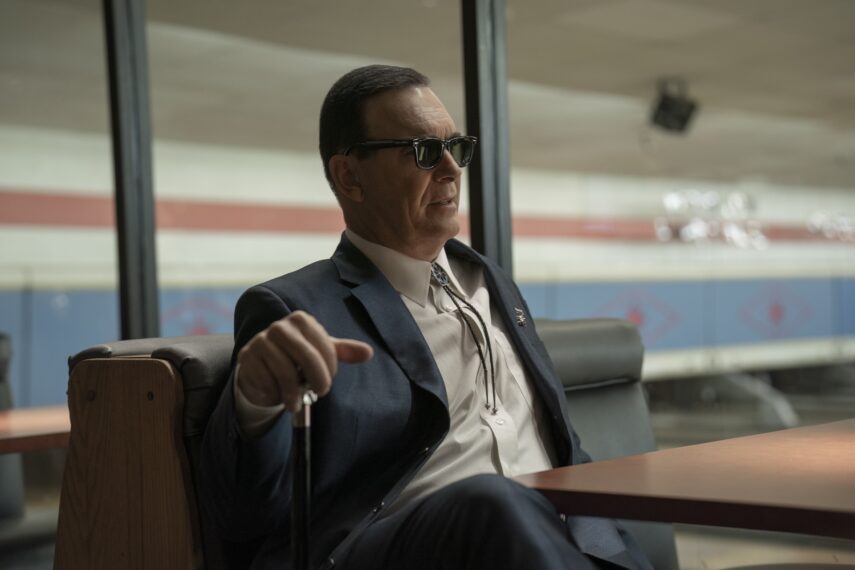
Max
The Elvis shoes adventure is an alt-history bit. Can you talk about the craftwork of that scene and how it builds to what we’re going to see later in the show?
Yeah, I mean, first of all, Sunglasses, Patrick, he’s just… I mean, to work with that actor, it was such a dream. He’s so hilarious. And this whole idea of Sunglasses, and the way those scripts kind of mess with expectation — you think you’re going to be dealing with this big heavy[hitter], and then he has this soft spot of loving Elvis paraphernalia. And Jim has a plan. Jim always thinks of the thing, but the thing he thinks of is actually really complicated and hard to achieve. And then we get to go with him, and his girlfriend happens to have been at the Elvis house. He knows how to get there. And creating the Elvis house at Albuquerque is a whole other hilarious story, of course, because we were in the desert trying to create that tropical paradise of a home. But yeah, I mean, the shoes will come in handy. I think that’s all I can probably say. The shoes will have a continued life and value for Jim.
You mentioned the bowling alley scene as well. It’s so brutal. There’s the noise of the crunch, it’s a lot, and it’s so great. Can you talk about just leaning into the wildness of that fight?
Yeah. I mean, I think when you asked about action, we can use that as another example of where sometimes something is comedic because we’re not focusing on gruesomeness. On the other hand, if you push it all the way and go gruesome but keep it snappy, then it’s another kind of action comedy, right? When something happens you would never imagine, and it has sort of a sick, comical edge that someone would just get mushed by a reset. So I think that’s just the mind of J.J. and LaToya thinking of the most absurd, violent end to someone. Because you love a bowling alley location, and they’re thinking, “Okay, what can happen in here?” that’s not someone just getting shot or someone getting beat up.
This episode has another element of this as we see some of the strains between Saxton and his daughter. Can you talk about helping to bring this character to light where he’s this larger-than-life figure, even to the FBI, but he also has such human issues?
Yeah, I love that about it. I think that’s really LaToya’s brushstroke, the daughter storyline…. And I love [that] Saxton wasn’t just a figurehead. He wasn’t a token mob boss. You really got into his family dynamics, and Josh’s character, Jim, is part of his family. So suddenly, you really get in there. And I think Sydney Elisabeth, she just did such a great job. She was very grounded, an authentic performance. I think it echoes Nina’s journey, too, that Nina wasn’t going to be the only woman looking for autonomy, independence, leadership in her life. It’s great to tell a story where there’s not just one version of that happening. So Saxton’s daughter is another opportunity to show a different kind of desire for women’s rights and autonomy. She wanted to be involved in the family business, but she wasn’t getting any responsibility. She wanted to love the person she wanted to love, but she wasn’t getting that respect. And then, of course, Jim teams up with her, kind of like a sister, later… There’s a continuation of her relationship with Jim, almost like a sibling. She helps him out, and he respects what she wants in life, and so it’s fun. We get to get in there and flesh these characters out. Nobody’s a figurehead, which is always such a relief.
Duster, Thursdays, 9/8c, Max

